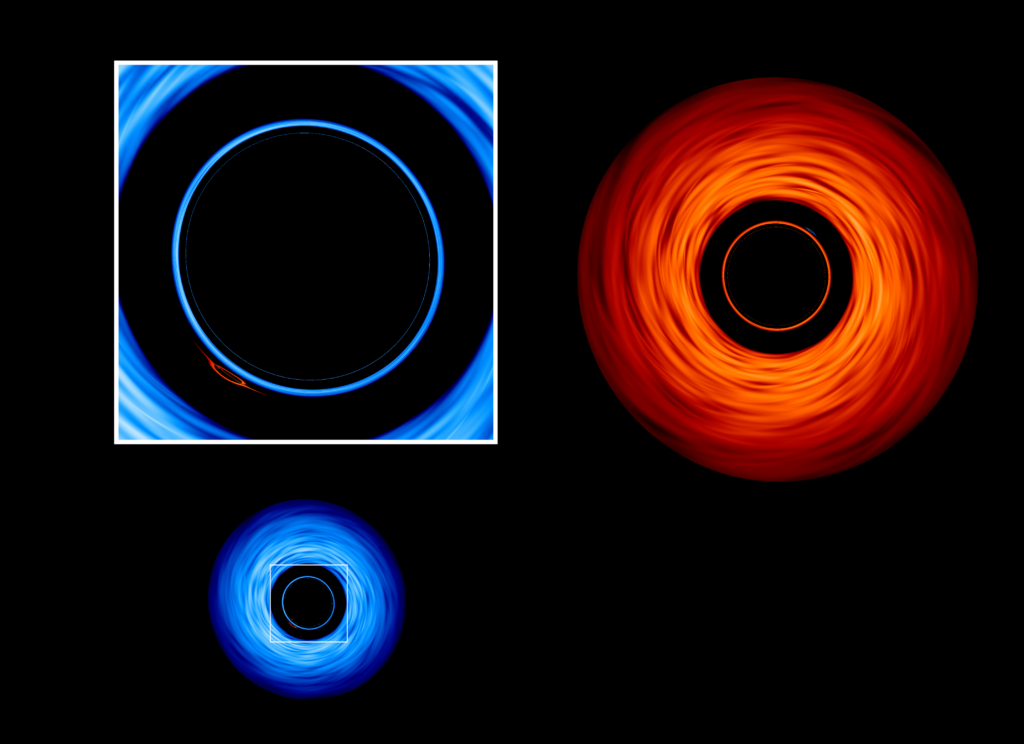A pair of orbiting black holes millions of times the Sun’s mass perform a hypnotic dance in this NASA visualization. The movie traces how the black holes distort and redirect light emanating from the maelstrom of hot gas – called an accretion disk – that surrounds each one.

Credit: NASA’s Goddard Space Flight Center/Jeremy Schnittman and Brian P. Powell
Viewed from near the orbital plane, each accretion disk takes on a characteristic warped look. But as one passes in front of the other, the gravity of the foreground black hole transforms its partner into a rapidly changing sequence of arcs. These distortions play out as light from the accretion disks navigates the tangled fabric of space and time near the black holes.
The simulated binary contains two supermassive black holes, a larger one with 200 million solar masses and a smaller companion weighing half as much. Astronomers think that in binary systems like this, both black holes could maintain accretion disks for millions of years.
Credit: NASA’s Goddard Space Flight Center/Jeremy Schnittman and Brian P. Powell
Music: “Gravitational Field” from Orbit. Written and produced by Lars Leonhard.
The disks have different colors, red and blue, to make it easier to track the light sources, but the choice also reflects reality. Gas orbiting lower-mass black holes experiences stronger effects that produce higher temperatures. For these masses, both accretion disks would actually emit most of their light in the UV, with the blue disk reaching a slightly higher temperature.
Visualizations like this help scientists picture the fascinating consequences of extreme gravity’s funhouse mirror.
Seen nearly edgewise, the accretion disks look noticeably brighter on one side. Gravitational distortion alters the paths of light coming from different parts of the disks, producing the warped image. The rapid motion of gas near the black hole modifies the disk’s luminosity through a phenomenon called Doppler boosting – an effect of Einstein’s relativity theory that brightens the side rotating toward the viewer and dims the side spinning away.
The visualization also shows a more subtle phenomenon called relativistic aberration. The black holes appear smaller as they approach the viewer and larger when moving away.

These effects disappear when viewing the system from above, but new features emerge. Both black holes produce small images of their partners that circle around them each orbit. Looking closely, it’s clear that these images are actually edge-on views. To produce them, light from the black holes must be redirected by 90 degrees, which means we’re observing the black holes from two different perspectives – face on and edge on – at the same time. Zooming into each black hole reveals multiple, increasingly distorted images of its partner.
The visualization, created by astrophysicist Jeremy Schnittman at NASA’s Goddard Space Flight Center in Greenbelt, Maryland, involved computing the path taken by light rays from the accretion disks as they made their way through the warped space-time around the black holes. On a modern desktop computer, the calculations needed to make the movie frames would have taken about a decade. So Schnittman teamed up with Goddard data scientist Brian P. Powell to use the Discover supercomputer at the NASA Center for Climate Simulation. Using just 2% of Discover’s 129,000 processors, these computations took about a day.
Astronomers expect that, one day, they’ll be able to detect gravitational waves – ripples in space-time – produced when two supermassive black holes in a system much like the one Schnittman depicted spiral together and merge.
Source:www.nasa.gov
